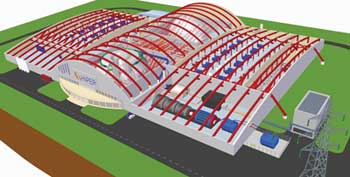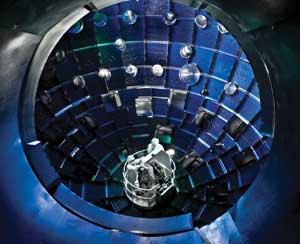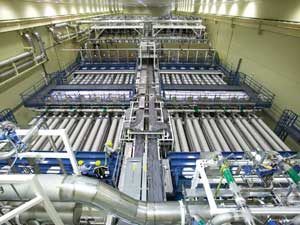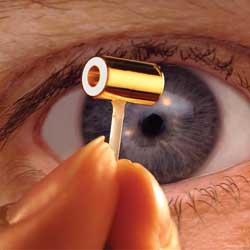In November 2010, the National Ignition Facility in the US fired the first shot toward a clean energy future. And Europe’s HiPER project will answer the call to arms.
Coal, oil and other fossil fuels may or may not have staying power beyond the next hundred years. Green energy, such as wind, geothermal, hydro and solar, will contribute to the world’s future energy needs, but probably not nearly enough to fulfill consumption. Nuclear energy has its friends and foes, but its efficiency may never overcome fears (rational or otherwise) over its safety.
Is there any potential energy source that could provide electricity to drive all of the world’s transportation, manufacturing, food production and entertainment needs cheaply and greenly for centuries to come?
High-energy laser researchers say the answer is most certainly “yes.”

An artist’s rendering of the proposed High Power Laser Energy Research (HiPER) facility, which will be designed to generate electricity from laser-driven fusion technology. Courtesy of HiPER.
The principles of laser-driven fusion were first conceived just three days after Ted Maiman’s demonstration of the ruby laser more than 50 years ago, according to Mike Dunne of the National Ignition Facility (NIF) in California.
As currently envisioned, fusion-based electricity generation would operate as follows: At a rate of about 16 Hz, 2-mm pellets containing deuterium and tritium are fed into the path of a high-energy ultraviolet laser beam. The beam causes the hydrogen isotopes to fuse together, creating helium nuclei and releasing high-energy neutrons.
A steady stream of pellets results in a steady stream of randomly emitted neutrons that heat a sheet of lithium surrounding the target chamber. Captured heat from this lithium “blanket” drives a steam turbine that generates electrical current ready to go to the local grid. A fusion facility such as this could produce 1500 MW of electrical power. By comparison, the Torness nuclear plant in Scotland, built in the late 1980s, produces under 1400 MW without the benefits of such technology.

The fusion target chamber at the National Ignition Facility in Livermore, Calif.
Courtesy of Lawrence Livermore National Laboratory.
Many of the world’s existing nuclear plants, which rely on fission physics – the splitting of atoms – are aging, and not well. Decommissioning them, however, is problematic because there is a lot of still-radioactive waste – from spent fuel rods to water-based coolants to the steel and cement buildings themselves – that will have to be disposed of carefully and securely. Fusion-based facilities, if they ever had to be decommissioned, would simply have to be taken apart and buried shallowly. No radioactive materials to worry about.
Generating electricity from fusionable materials cannot lead to runaway reactions feared with fission-based nuclear facilities. Meltdown calamities at Three Mile Island in the US and Fukushima Daiichi in Japan, and the radiation release from doomed Chernobyl in Ukraine, have inflamed passionate antinuclear sentiments among citizens of many nations. Using fusion to create electricity does not carry this stigma.
Besides safety, fusion has the leg up on fission in terms of fuel expense and availability. Deuterium and tritium are abundantly available from water and lithium. The sea is completely acceptable as the water source. Lithium is ubiquitous, too; it is in the soil nearly everywhere you turn, but there also are major deposits in Chile, Bolivia and other South American locales.
Going HiPER
NIF, located at Lawrence Livermore National Laboratory in California, is the largest scientific project ever built by the US Department of Energy. Completed in 2009, it has undergone a series of test firings of its massive banks of high-power lasers – 192 beams capable of testing fusion targets with as much as 2 MJ of energy at ultraviolet wavelengths.

This bank of high-power lasers at the National Ignition Facility will be a common feature of fusion-based electrical facilities such as HiPER. Courtesy of Lawrence Livermore National Laboratory.
In November 2010, researchers at NIF fired a 1.3-MJ beam for the first time at a hohlraum, a tiny cryogenically cooled cylinder containing a fusion target surrogate. In March this year, the facility marked its third anniversary by exceeding 2 MJ for the first time. When the lasers are at last aimed at a live fusion target (composed of a mixture of deuterium and tritium), the NIF team will ascertain whether that much input power can be translated into even higher output power, some 10 to 100 times as much if all goes well.
Once NIF has reached the first ignition milestone, the scientists will focus on generating power with high gain. Their research will ultimately lead to the Laser Inertial Fusion Energy project, which should become, by the 2020s, the first operating fusion-based plant on the electrical grid. In Europe, the technology will be further explored at the PETAL (Petawatt Aquitaine Laser) facility in southwestern France. In turn, PETAL will act as the forerunner to HiPER, the proposed High Power Laser Energy Research facility, which likely will be sited in the UK.
The hope for the NIF, HiPER and other high-energy fusion projects in the future is to generate more energy than they consume. Whatever is learned at NIF over the next several years will directly inform the HiPER project.
“Demonstration of alpha heating, ignition, burn and, eventually, net target energy gain at the National Ignition Facility are important technological milestones which will help to justify national investment in the HiPER technology development phase and give confidence in the scientific viability of laser energy,” said Chris Edwards, director of the project.
Besides churning out electrical energy, HiPER is expected to contribute to high-energy physics, materials and astrophysics research. As does NIF, HiPER will be designed to achieve temperatures up to hundreds of millions of degrees, a billion atmospheric pressures and similarly large electromagnetic fields. At these extremes, for example, it is expected to allow researchers to study direct nuclear excitation by laser radiation for the first time.
Currently, the exploratory nature of the NIF research means that test firings and the first ignition studies are all being performed one shot at a time, not anywhere near 16 Hz.
“It is clear from economic studies that commercial viability of laser energy requires fusion of fuel capsules to be initiated at repetition rates in the 10-Hz to 20-Hz regime,” Edwards said. “HiPER has therefore adopted a rep-rate strategy in every aspect of its mission. This requires development of high-efficiency, high-repetition-rate, low-cost ‘next-generation’ laser drivers; injection of targets into the fusion chamber at high velocity; automatic tracking and engagement of the targets by the laser; and a systems engineering approach to the fusion chamber operating environment.”

The fuel for future fusion-driven electrical plants will be pea-size pellets containing the hydrogen isotopes deuterium and tritium. Courtesy of Lawrence Livermore National Laboratory.
Crucially, Edwards added, HiPER will be equipped with a neutron energy extraction blanket with tritium generation to enable all stages of the technology to be demonstrated and its performance assessed.
HiPER is in the last year of its preparatory phase, he said. This phase will be followed by a technology development phase lasting eight to 10 years that will be largely funded by the national governments of participating states. Funding from the European Union for HiPER runs through April of next year. Funding campaigns already are under way, with even cash-strapped Greece and Spain expected to contribute.
“It is hoped that [European Commission] support will be available to the project as a contribution to management and coordination costs,” Edwards said. “This requires negotiation, as the technology development phase lies between ‘preparatory’ and ‘implementation’ stages.”
Making reasonable assumptions of progress in the technology development phase, he added, a proposal to construct the HiPER facility could be ready by the early 2020s and the plant operational within a decade after the beginning of construction. Funding for construction likely would come from private-sector investors or through a private/public partnership.
The development of low-cost laser drivers that provide high peak, average power and high efficiency is an essential part of the HiPER technology development phase to come.
“The commercial, technological and scientific impact of such systems will be truly immense,” Edwards said. “Importantly, research programs on such systems here in the UK, in France, Germany, US and Japan all suggest that the required performance can be demonstrated and commercialized in the short to medium term (five to eight years).”
The challenge, he said, is to obtain funding for the technology development phase at a national level when spending on research is highly constrained by the current economic situation.
“I believe that, ultimately, we will be successful, given the economic benefits available en route combined with ever-increasing energy prices and growing environmental awareness,” he said.
HiPER Participating Nations
Czech Republic
France
Germany
Greece
Italy
Poland
Portugal
Russia
Spain
United Kingdom